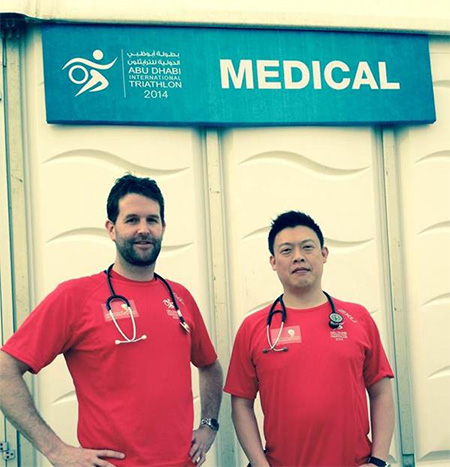
Doctors Rick Seah and Courtney Kipps, both consultants in Sport & Exercise Medicine (SEM) at the ISEH, flew out to the United Arab Emirates in March 2014 as part of the medical team for the Abu Dhabi International Triathlon 2014.
The annual competition attracted elite athletes from across the globe, including the UK's Olympic triathlon gold and bronze-winning medallist brothers Alistair and Jonny Brownlee, and former women's Ironman 70.3 world champion Jodie Swallow. Alongside the elite race, 2400 dedicated amateur triathletes also took part in the mass-participation race, competing in the long, short or sprint distances.
Children from local Abu Dhabi schools also participated in a mini-version of the triathlon the day before, helping to promote the notion of exercise and physical activity in the young. Perhaps a future Triathlon World Champion may arise from that bunch!
The medical team comprised a group of experienced doctors from Australia and the UK. This was the 5th time Rick has participated as a medical officer since its inception in 2010. Although this was Courtney's inaugural attendance as a member of the ADIT medical team, he is a seasoned triathlon doctor, holding the current role of medical director for the London Triathlon. Both have previously worked as sports physicians at other mass participation events in the UK such as the London Marathon, Blenheim Triathlon and ITU World Triathlon Series events in Hyde Park, London.
The sport of triathlon starts off with a swim, then a cycle, followed finally by a running leg. Extensive training is required as the long distance event can last anywhere from 4-6 hours for most athletes. Environmental factors such as the ambient air temperature, water temperature and sun exposure all play a role in the extent and severity of injuries and illnesses that may arise on the day.
Medical problems arising from such mass participation events include exercise-associated collapse from causes such as heatstroke, dehydration, and hyponatraemia (low sodium levels arising from overdrinking); and musculoskeletal problems including fractures, and overuse tendon, muscle and ligament injuries.